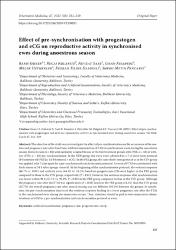| dc.contributor.author | Güner, Barış | |
| dc.contributor.author | Kulaksız, Recai | |
| dc.contributor.author | Saat, Nevzat | |
| dc.contributor.author | Kısadere, İhsan | |
| dc.contributor.author | Öztürkler, Melek | |
| dc.contributor.author | Dalgınlı, Kezban Yıldız | |
| dc.contributor.author | Pancarcı, Şükrü Metin | |
| dc.date.accessioned | 2023-12-28T07:11:41Z | |
| dc.date.available | 2023-12-28T07:11:41Z | |
| dc.date.issued | 2022 | en_US |
| dc.identifier.issn | 0375-8427 / 1805-9392 | |
| dc.identifier.uri | https://doi.org/10.17221/244/2020-VETMED | |
| dc.identifier.uri | https://hdl.handle.net/20.500.12462/13702 | |
| dc.description | Güner, Barış (Balikesir Author) | en_US |
| dc.description.abstract | The objective of the study was to investigate the effect of pre-synchronisation on the occurrence of the oestrus and pregnancy rate after fixed time artificial insemination (FTAI) in synchronised ewes during the anoestrous season. Kivircik ewes (n = 84) were randomly assigned to one of the two treatment groups with (PRE; n = 42) or without (SYN; n = 42) pre-synchronisation. In the SYN group, the ewes were subjected to a 7-d short-term protocol (P4 insertion-6d-PGF2 alpha-1d-P4 removal + eCG). In the PRE group, the same short-term protocol as in the SYN group was applied with 7 days apart for a pre-synchronised synchronisation protocol. A cervical FTAI was performed with fresh semen at 54 h after sponge removal. At the beginning of the synchronisation protocol, the oestrous response (66.7% vs. 0.0%) and cyclicity rates (64.3% vs. 14.3%) based on progesterone (P4) were higher in the PRE group compared to those in the SYN group, respectively (P < 0.01). However, the oestrous response after synchronisation was lower within 96 h (57.1% vs. 95.2%; P < 0.01) in the PRE group compared to that in the SYN group. Although the pregnancy rate after the FTAI was significantly (P < 0.05) lower in the PRE group (14.3%) than the SYN group (35.7%), the overall pregnancy rate after natural mating was not different (95.2%) between the groups. In conclusion, the pre-synchronisation decreased the oestrous response leading to a lower pregnancy rate after the FTAI in the synchronised ewes during the anoestrous season. Thus, attention should be paid to two consecutive administrations of eCG in a pre-synchronisation and synchronisation protocol in ewes. | en_US |
| dc.description.sponsorship | Balikesir University, Scientific Research Projects Coordination Unit (BAP Project) 2019/059 | en_US |
| dc.language.iso | eng | en_US |
| dc.publisher | Czech Academy Agricultural Sciences | en_US |
| dc.relation.isversionof | 10.17221/244/2020-VETMED | en_US |
| dc.rights | info:eu-repo/semantics/openAccess | en_US |
| dc.subject | Artificial Insemination | en_US |
| dc.subject | Pregnancy Rate | en_US |
| dc.subject | Progesterone | en_US |
| dc.subject | Sheep | en_US |
| dc.title | Effect of pre-synchronisation with progestogen and ecg on reproductive activity in synchronised ewes during anoestrous season | en_US |
| dc.type | article | en_US |
| dc.relation.journal | Veterinarni Medicina | en_US |
| dc.contributor.department | Veteriner Fakültesi | en_US |
| dc.contributor.authorID | 0000-0001-6414-6752 | en_US |
| dc.contributor.authorID | 0000-0002-8135-6142 | en_US |
| dc.contributor.authorID | 0000-0003-0732-0464 | en_US |
| dc.contributor.authorID | 0000-0002-4575-8435 | en_US |
| dc.identifier.volume | 67 | en_US |
| dc.identifier.issue | 5 | en_US |
| dc.identifier.startpage | 231 | en_US |
| dc.identifier.endpage | 239 | en_US |
| dc.relation.publicationcategory | Makale - Uluslararası Hakemli Dergi - Kurum Öğretim Elemanı | en_US |


















